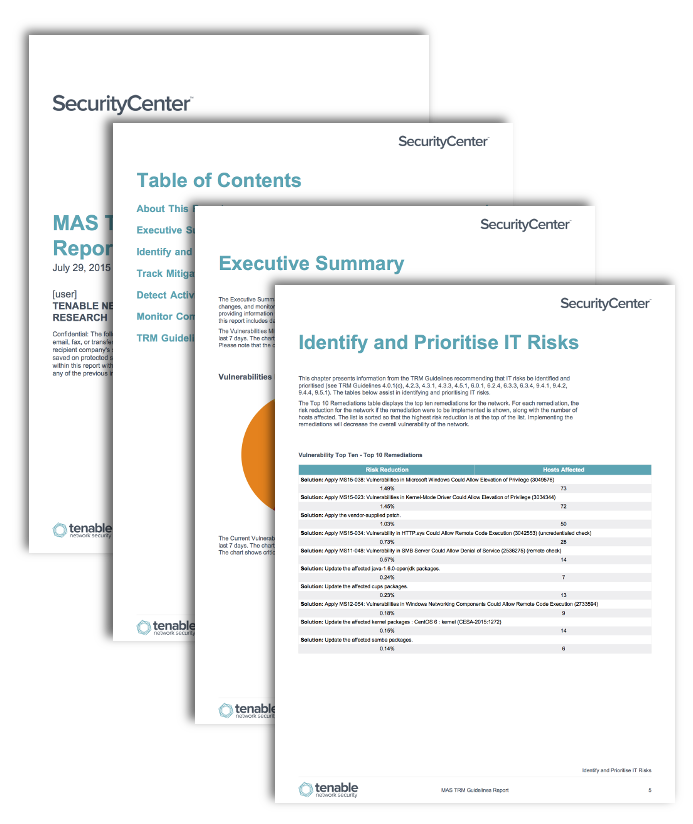by Stephanie Dunn
August 11, 2015

With attacks against financial institutions on the rise, the need to implement a multi-layered security strategy to combat threats is vital. The Monetary Authority of Singapore (MAS) responded by publishing the Technology Risk Management (TRM) Guidelines in June 2013. This report can address multiple sections within the TRM Guidelines by detecting active and mitigated vulnerabilities, tracking network changes, and providing detailed information on systems against existing compliance standards.
The TRM Guidelines set out risk management principles and best practice standards to guide financial institutions in establishing a sound and robust technology risk management framework; strengthening system security, reliability, resiliency, and recoverability; and deploying strong authentication to protect customer data, transactions, and systems. The objective of the Guidelines is to promote the adoption of sound practices and processes for managing technology. Applicable sections of the TRM Guidelines are noted for each component in the report.
The MAS TRM Guidelines report addresses several sections within the TRM Guidelines. By identifying and prioritising IT risks, the analyst can monitor remediations, detect active vulnerabilities, and identify the most vulnerable hosts on a network that need attention. When tracking risk mitigations, the information provided in this report can assist the analyst by determining what systems have been patched successfully. In addition, the analyst can utilize the Tenable.sc ticketing system to monitor overall mitigation progress. Additional components included within this report identify detected network changes, potential suspicious activity, and status of security solutions. This report also provides compliance information against existing regulatory requirements and standards. By staying compliant, organisations can ensure that data remains confidential and secure.
The report is available in the Tenable.sc Feed, a comprehensive collection of dashboards, reports, assurance report cards and assets. The report can be easily located in the Tenable.sc Feed under the category Compliance & Configuration Assessment. The report requirements are:
- Tenable.sc 4.8.2
- Nessus 8.5.1
- NNM 5.9.0
- LCE 6.0.0
- Tenable NetFlow Monitor
Any failure or breach within a financial institution can have significant impact on business operations, reputation, and can incur severe penalties due to non-compliance. By performing due diligence, organisations can identify gaps within current processes and practices, and aid in remediating issues.
Tenable.sc Continuous View (CV) is the market-defining continuous network monitoring platform. Tenable.sc CV includes active vulnerability detection with Nessus and passive vulnerability detection with the Nessus Network Monitor (NNM), as well as log correlation with the Log Correlation Engine (LCE). Using Tenable.sc CV, an organisation will obtain the most comprehensive and integrated view of its network.
The following chapters are included in the report:
Executive Summary: This chapter provides a general view on identified risks, mitigation progress, detected changes, and monitoring compliance highlighted within sections of the MAS TRM Guidelines report.
Identify and Prioritise IT Risks: This chapter presents information from the TRM Guidelines recommending that IT risks be identified and prioritised. The Top 10 Remediations table displays the top ten remediations for the network. The list is sorted so that the highest risk reduction is at the top of the list. The Top 10 Exploitable Vulnerabilities table presents the top ten hosts that have the greatest number of exploitable critical and high vulnerabilities. Also included within this report is the Top 10 Most Vulnerable Hosts table, which displays the top hosts that have the greatest number of exploitable critical and high severity vulnerabilities.
Track Mitigation Progress: This chapter and components below assist in tracking the status of vulnerability mitigations. The Vulnerability Summary matrix presents vulnerability summary information by severity, including information on mitigated and unmitigated vulnerabilities, known exploits available, and patches available. Additional features include a Ticket Status summary table displaying the number of tickets, and the status of each ticket.
Detect Activity: This chapter presents information on detected activity and changes. Details within this chapter provide information on status of new and existing devices, user, and application changes. Other components included within this chapter display indicators on network changes detected, and monitors security solutions within the last 72 hours. Additional components presented assist in providing prompt detection of suspicious activity and data leaks based on one or more Log Correlation Engine (LCE) events.
Monitor Compliance: This chapter provides a ratio view of systems that have been checked for a variety of compliance standards. The ratio bar provides a visual of the number of compliance checks that have either passed or failed, or that require manual verification. This information presented in this chapter assists with TRM Guidelines compliance by establishing baselines and measuring compliance.